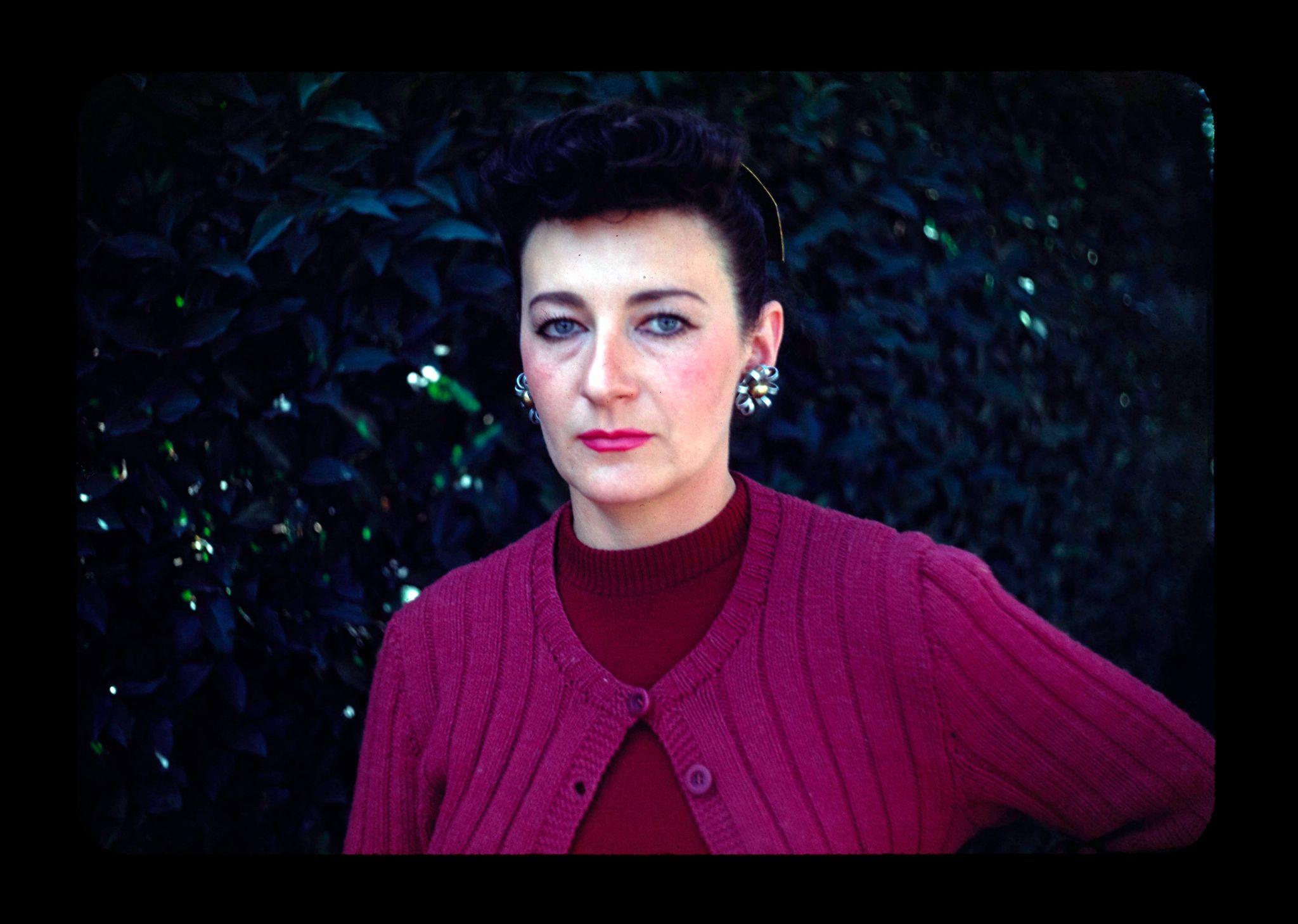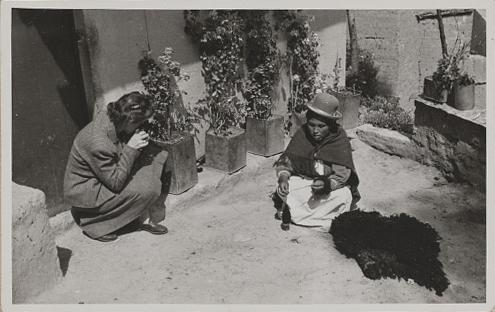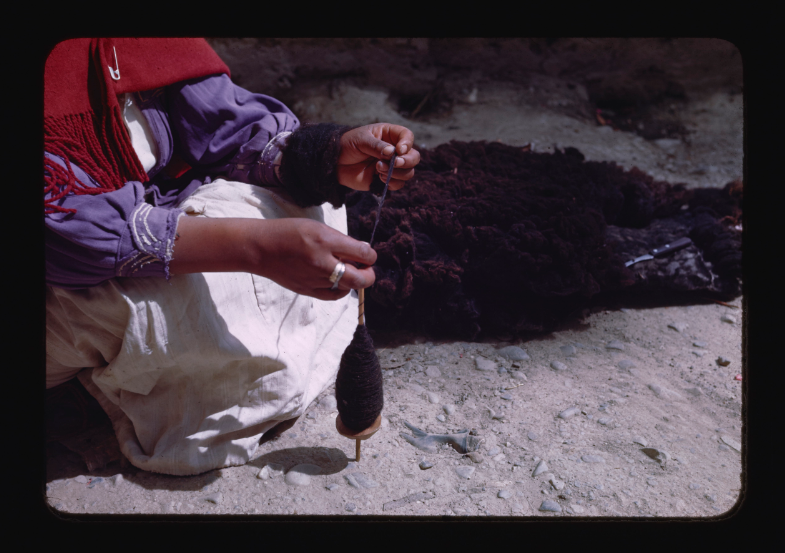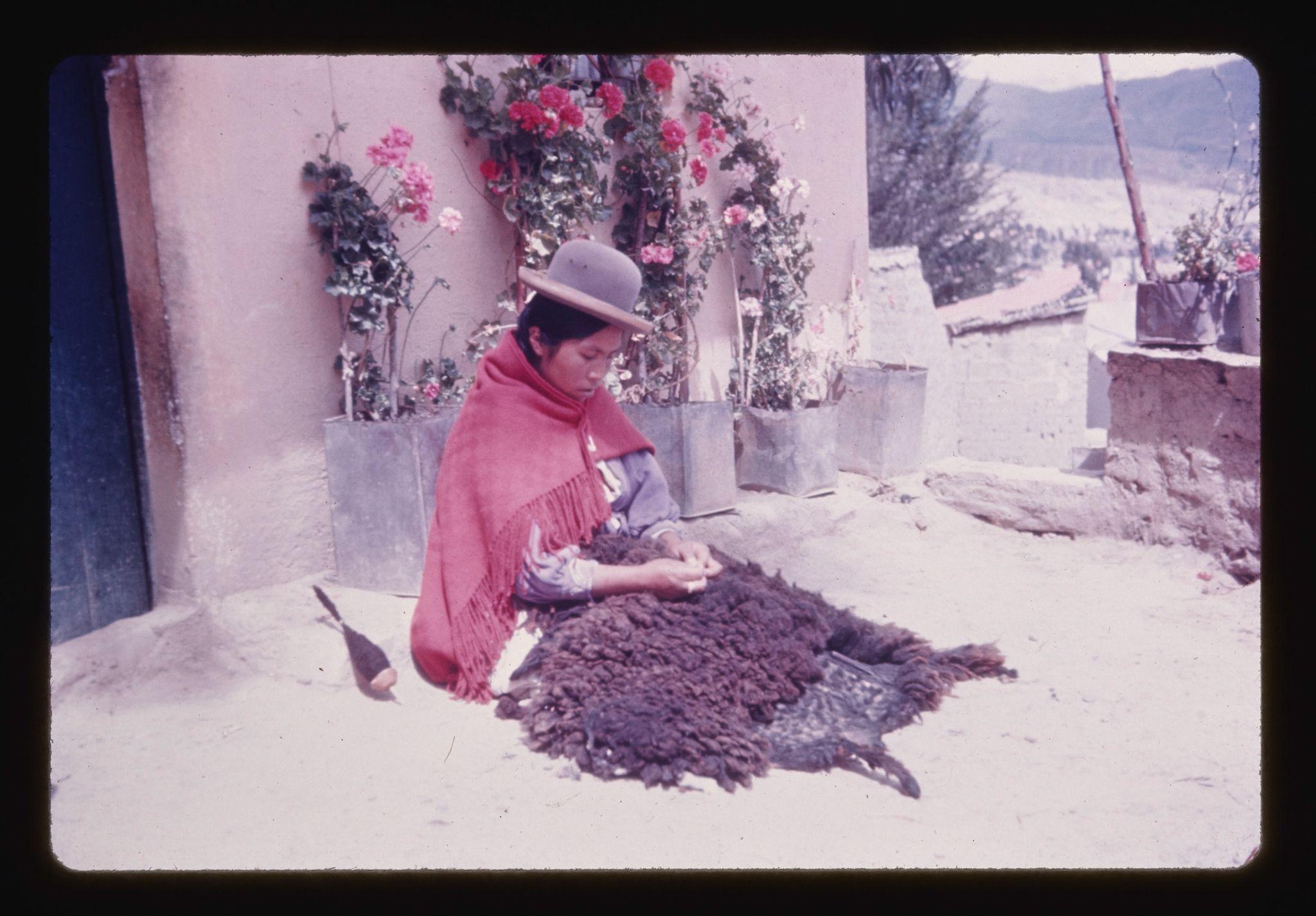The Florence Arquin Slide Project: Art, Pan-Americanism, and the Digital Humanities
PDF: Fenichel and Afanador-Llach, Florence Arquin Slide Project
In 2016, Emily Fenichel ventured into a small windowless room at Florida Atlantic University (FAU) in Boca Raton to look at a set of slides. At the time, few people had keys to the office and even fewer knew about the slides. After examining them and researching the collection, Fenichel showed them to her colleague, Camila Afanador-Llach, a graphic design professor. Together, we agreed that the collection was a good candidate for a digital humanities project because of its unique history, the strength of the images, and the fact that they were largely inaccessible as slides. Few people either on or off the campus could see them or use them as research materials. Together, we developed the Arquin Slide Collection, which uses specific metadata, geolocations, and open-source software to help fulfill the original promise of the collection: to educate the broader public about Latin America. In what follows, we provide a brief history of the collection; explore how it engages with pertinent themes in the study of American art, such as Pan-Americanism, colonialism, feminism, and collaboration; and outline how we provided both preservation for and access to the collection using a digital humanities approach for archiving, design, and digital curation.
The Collection
Florence Arquin was an artist, art historian, educator, and photographer who amassed a large collection of slides, predominantly of subjects from Latin America. She exhibited her work in Mexico City, wrote a book about Diego Rivera, and was friends with him, Frida Kahlo, and other members of the modern Mexican art scene.1 Through her connections to this community and her experiences as an arts educator for the Illinois state government, Arquin perceived a need for educational materials on Latin America in the United States and lobbied the US government to provide her with a position in which she might do something about it. Eventually, Arquin received grant money and a one-year position as director of the Kodachrome Slide Project from 1944 to 1945.2 Housed under the Office of Inter-American Affairs (OIAA) and the US Office of Education, the position required Arquin to acquire slides on Latin America from collections around the United States, organize them into thirty-three distinct presentations with scripts, and copy and distribute them to institutions—primarily high schools and colleges—around the United States. Arquin’s final report in 1945 emphasized that there were almost no educational slides from Latin America—besides the ones Arquin herself had taken as a private citizen in Mexico—available in the United States.3 By 1946, Arquin had been hired as an “exchange specialist” with the State Department to take high-quality color slides of people, art, and architecture in Bolivia, Brazil, Peru, Ecuador, and Mexico.4 These images make up the majority of the slides now held at FAU.5 To this day, it is one of the largest single-photographer collections of images of Latin America in the United States.
Arquin’s papers, now in the Archives of American Art, give evidence that she planned a tour through Latin America, organized the slides, wrote scripts for the slide sequences, and publicized them throughout the United States.6 These archives, however, do not include any of the slides Arquin made during her time with the State Department. FAU’s collection thus completes the picture of Arquin’s undertaking.

Cultural exchange initiatives, like the Kodachrome Slide Project, were popular in the United States during the 1940s.7 Such programs attempted to develop a sense of community and familiarity with countries in the Western hemisphere, thereby encouraging economic and political cooperation. The OIAA was created by President Franklin D. Roosevelt in the 1940s in order to foster such collaboration.8 As Annette B. Cottrell, director of the Speakers Service Bureau for the OIAA, put it in a letter to Arquin in 1944, “This Office is interested in doing everything possible to strengthen the bonds that unite the nations of the Western Hemisphere.”9 It is clear that Arquin saw her role in the Kodachrome Slide Project as furthering these goals, writing that the slides were an “opportunity to promote . . . the Pan American movement,” and presented a strong “challenge in remedial teaching to counteract the erroneous impressions of the exotic, primitive, and picturesque . . . synonymous with Latin American arts and crafts.”10 Despite Arquin’s intentions, Richard Candida Smith argues that such exchanges were often self-serving efforts by the United States to extend their reach as a global power.11 Arquin’s own images—particularly those of women—show how fraught an enterprise Pan-Americanism could be. Arquin was not always successful in counteracting the “erroneous impressions” of Latin America. Moreover, her images highlight a number of themes that run throughout the collection that are pertinent to the study of American art and documentary photography.
Arquin’s slides could be strikingly feminist.12 She photographed female artists and their work at a time when few had a reputation outside of Mexico City, including Frida Kahlo, Olga Costa (fig. 1), Maria Izquierdo, and Alice Rahon.13 Arquin treated her female subjects as individuals, foregrounding their creations and focusing on their faces; she worked collaboratively with her subjects on equal footing.14 Many of these women were like Arquin—educated, professional, and cosmopolitan—and she was eager to celebrate them.
The same cannot be said for her images of Indigenous women, as evident, for example, in the three slides Arquin made of the same Bolivian spinner (fig. 2). These shots do not focus on the woman’s face but instead emphasize her handicraft and her distinctive garb. Despite Arquin’s desire for those in the United States not to see Latin America as “exotic, primitive, or picturesque,” she created images that reinforce such a narrative. Instead of presenting the Indigenous artisan as an individual, she focused on her tools and craft—which would have seemed foreign and simple to contemporary US viewers. In addition, it does not seem that the collaboration between photographer and subject in this case was equitable.15 Arquin’s choices—placing herself at a distance from her subject and cropping out her subject’s face—raise questions about whether she saw herself as superior to this woman.
Moreover, these images are suffused with the quasi-imperial underpinnings that characterized the American government’s Pan-Americanism.16 Identified merely as an “Indian” in Arquin’s notes, the Indigenous artisan is reduced to one of the faceless masses in the distant country of Bolivia. Arquin’s documentation as an agent of the US government was also self-conscious. Her papers include a photograph of Arquin working as chair of the Kodachrome Slide Project and taking the image of the Bolivian spinner (fig. 3). This image of herself as a professional woman in a tailored suit contrasts sharply with that of the Native woman beside a pile of wool, and it emphasizes the cultural and economic gap between the United States and the rest of the hemisphere.

However, the fact that any of slides of Arquin’s rich archive can be brought into conversation with colonialism, feminism, and collaboration in photography is a testament to the importance of the collection. And there are thousands of images in the Arquin Slide Collection at FAU. The size and scope of the collection, together with its Pan-American origins, demonstrate its significance as a research tool for those studying American art and culture.
It was always a goal that the slides be an educational tool. Despite Arquin’s efforts, few slides or sequences were purchased in the 1940s and 1950s.17 The State Department deaccessioned the entire collection in 1963 and gave it back to Arquin. That same year, the state of Florida agreed that Arquin’s slides would make an excellent collection for the newly opened FAU and authorized their purchase.18 FAU intended to use them for research and education.19 For several decades, the slides were used for classroom instruction and presentations to the public in Boca Raton. In subsequent years, the slides were eclipsed by digital images used by the art history program. By 2016, when we looked into the collection, there was no one left at the university who had any firsthand knowledge of it. We set out to digitally preserve the slides and to provide access to them for students and researchers alike, thereby fulfilling some of the original intentions of the collection. The result is a public website and a tool to enable others to ask probing questions about the art and culture of Latin America.
The Digital Humanities Project
We applied for funding from the National Endowment for the Humanities and were awarded a Humanities Collections and Reference Resources Grant in 2020. Upon digitizing the slides with an external vendor, we formed a team of three student workers who, for two years, wrote metadata for each item in the collection. We devised guidelines for the metadata input, made corrections, and created translations. This documentation helped keep the project organized, and we envisioned that it could serve as a reference for similar undertakings in our institution. An incomplete typewritten catalogue created sometime after the university purchased the slides was our main initial reference point to create metadata for the slides. We copied descriptions and locations from the catalogue and transcribed notes that Arquin herself wrote on the slide mounts for uncatalogued items. To ensure consistency in our descriptions of the wide variety of subjects and locations present in the slides, we decided to use Getty vocabularies.20 Throughout this process, we discussed using sensitive language in slides showing Indigenous populations. For example, Arquin and the original catalogue had categorized certain images, like the ones of the Bolivian spinner, as “Indian Life.” We agreed to keep Arquin’s original terms in the description field of the metadata. To make sure that we used more appropriate terms in our controlled vocabulary and titles, we decided on “Indigenous peoples” as the subject term for such images.
In order to expand access to the collection to other countries—especially throughout Latin America—we translated a portion of the metadata into Spanish and Portuguese. In this way, we hope to broaden the scholarly audience who can interact with the material and address some of the inherent colonialism in digital collections and implicit in Pan-Americanism. In our search for standards and best practices, we found that multilingual metadata and display is a topic that is not addressed in many digital collections. We looked at resources like Europeana to research the best practices for multilingual access and ultimately decided on a process for the translation and the display of multilingual metadata working within the capabilities of Omeka S and in consultation with an information-sciences expert.21 We generated a list of unique titles and then used a script that connects Google Translate to our metadata spreadsheet in order to generate automatic translations in Spanish and Portuguese. We also produced a list of unique subjects and pulled the available translations from the Getty vocabularies. During the last year of the grant, we worked with three student translators of Spanish and Portuguese from the Department of Languages, Linguistics, and Comparative Literature at FAU, who edited and completed the automated translations for accuracy. Following best practices for displaying the metadata of each item on the website, we used language tags to identify the translated metadata fields (fig. 4).

While digitization and cataloging were central to the project, another goal was to create digital exhibitions on the website. Through these, we introduce images from the collection with interpretation, nuance, and contextual history. For example, the exhibition Arquin and Asúnsolo shows photographs of art dealer Maria Asúnsolo next to portraits of her made by several modern Mexican artists. Another exhibit is focused on the relationship between Arquin and modern Mexican painters. Creating these exhibitions in Omeka has driven our ongoing engagement with digital curation of the collection.
Technical Limitations
Institutional limitations shaped the way in which the project was executed. We worked independently from the University Libraries that, at the time, could not offer the type of support and expertise our project required. FAU’s Office of Information Technology supported the project with technical assistance for the front and back end of the Omeka S website and for long-term digital preservation. Working with an open-source platform like Omeka was convenient because it is built for digital collections. It uses standard conventions of visual design, user experience, and web accessibility that guide how the digital collections are displayed, but it does have some limitations. With the support of the web development team, we customized the web layouts and explored the possibilities within Omeka. We had to adjust our goals as we learned what was possible with the resources and expertise we had available to us.
For example, we georeferenced each image with the ambition of having researchers discover images through an interactive map similar to the one used in Yale’s Photogrammar project.22 Throughout the development of the project, we had tested our ability to do a version of this with a small number of items using Omeka’s mapping module. But when we were finally importing all the metadata into Omeka, we learned that the platform would only allow us to display markers for about one third of the images in a single map. We decided to keep all georeferencing data but instead of a comprehensive map with all items, we created individual maps grouping countries together. For example, one of the maps shows all the slides that Arquin took in Mexico, Guatemala, Cuba, Haiti, the Dominican Republic, and Puerto Rico. In addition, each individual item page includes georeferencing data and a map.
Conclusion
In creating our database and website, Arquin’s slide project has come almost full circle. The collection has been reintroduced as a resource for education and research. Our cataloging of the metadata and our exhibitions, however, highlight how the images are bound up with the central concerns and themes of the study of American art and culture, including the legacy of Pan-Americanism and the impact of feminism, collaboration, colonialism, and Indigenous studies. These concerns seem especially pertinent at a Hispanic-serving institution in Florida at a time when the state is actively seeking to chill discussion on such topics. Moreover, we have attempted to make the project into something that is accessible for researchers throughout Latin America by including translations. In this way, US scholars can not only learn about Latin America in the mid-twentieth century, but Latin American scholars can learn about their own countries and how they were perceived by the US government during the 1940s.
The digitization of the slides has opened them up to a far wider audience than they would have had if they had remained physical slides. The website is generating nearly two thousand hits a month and has already been a vital resource for a graduate student at the Art Institute of Chicago. Arquin may not have sold many slide sequences in her time, but FAU’s Arquin Slide Collection has provided preservation and access to her important images some eighty years after their creation.
Cite this article: Emily A. Fenichel and Camila Afanador-Llach, “The Florence Arquin Slide Project: Art, Pan-Americanism, and the Digital Humanities,” Panorama: Journal of the Association of Historians of American Art 10, no. 1 (Spring 2024), https://doi.org/10.24926/24716839.18962.
Notes
- Florence Arquin, Diego Rivera: The Shaping of an Artist, 1889–1921 (Norman: University of Oklahoma Press, 1971). See her correspondence with artists in Florence Arquin papers, 1923–85, Archives of American Art, Smithsonian Institution (hereafter Arquin papers), https://www.aaa.si.edu/collections/florence-arquin-papers-5413/series-2. Arquin also exhibited her paintings in Mexico City. Rivera wrote the foreword to her exhibition catalogue. For more on Arquin’s paintings in Mexico, see Elizabeth Frasco, “American Women Artists of the New Deal and Mexico, 1934–1943″ (PhD diss., New York University, 2020), esp, chap. 3. ↵
- Aquin to Robert C. Smith, box 4, folder 28: Correspondence, 1942–45, Arquin papers, https://www.aaa.si.edu/collections/florence-arquin-papers-5413/subseries-4-3/box-4-folder-28. ↵
- See letters in box 4, folder 28: Correspondence, 1942–45, Arquin papers. Arquin discusses the importance of her slides in the historical moment in “Kodachrome Slides of Latin America,” Hispania 28, no. 3 (August 1945), 337–39. ↵
- Box 1, folder 2: Biographical Sketches and Resumes, 1939–1962, Florence Arquin papers, https://www.aaa.si.edu/collections/florence-arquin-papers-5413/series-1/box-1-folder-2. The OIAA was founded in 1940 and subsumed under the Department of State in 1945. From 1949 to 1950, Arquin was again employed by the State Department as the Coordinator of the Latin American Slide Project to organize the slides she had taken as an exchange specialist. ↵
- Later, Arquin expanded her travels and accrued slides taken in Europe and North Africa. ↵
- In 1951, Arquin returned to the countries where she had taken slides in order to show her images and lecture about her experiences. See Arquin’s Scrapbook 1950–1956, box 10, Folder 1, Arquin papers, https://www.aaa.si.edu/collections/florence-arquin-papers-5413/series-8/box-10-folder-1. ↵
- Richard Candida Smith, Improvised Continent: Pan-Americanism and Cultural Exchange (Philadelphia: University of Pennsylvania Press, 2017). ↵
- The OIAA was part of the “Good Neighbor” policy. ↵
- Annette B. Cottrell to Arquin, 1944, box 4, folder 28, Arquin papers, https://www.aaa.si.edu/collections/florence-arquin-papers-5413/subseries-4-3/box-4-folder-28. ↵
- Annette B. Cottrell to Arquin, 1944, box 4, folder 28, Arquin papers, https://www.aaa.si.edu/collections/florence-arquin-papers-5413/subseries-4-3/box-4-folder-28. ↵
- Candida Smith, Improvised Continent, 3–4. ↵
- It is not clear to me that Arquin saw herself as a feminist. She never refers to herself as such in any of her papers that I have read. ↵
- See Nancy Deffebach, María Izquierdo and Frida Kahlo: Challenging Visions in Modern Mexican Art (Austin: University of Texas Press, 2015), 4–6; “Frida Kahlo and the Archives of American Art,” Google Arts and Culture, accessed January 30, 2024, https://artsandculture.google.com/story/ygWxUtETc0ZEKA?hl=en. ↵
- Ariella Azoulay, “Photography Consists of Collaboration: Susan Meiselas, Wendy Ewald, and Ariella Azoulay,” Camera Obscura: Feminism, Culture, and Media Studies 31, no. 1 (May 2016), 187–201. In Arquin’s notes, she demonstrates that she is sensitive to the women’s personalities. She writes “Olga Costa, both as a person and an artist is simple, direct, unpretentious”; “Three Women Painters in Contemporary Mexican Art,” c. 1940, box 4, folder 2, Arquin papers, https://www.aaa.si.edu/collections/florence-arquin-papers-5413/series-3/box-4-folder-2. ↵
- Azoulay, “Photography Consists of Collaboration,” 188. In Azoulay’s argument, collaboration is not necessarily equal and is not always a positive force. ↵
- Candida Smith, Improvised Continent, 3–4. The OIAA’s charge (understood as Pan-American policy at the time) was “to provide for the development of commercial and cultural relations between the American Republics and thereby increasing the solidarity of this hemisphere and furthering the spirit of cooperation between the Americas in the interest of hemisphere defense”; Franklin Delano Roosevelt, “Executive Order 8840—Establishing the Office of the Coordinator of Inter-American Affairs in the Executive Office of the President and Defining Its Functions and Duties,” July 30th, 1941, The American Presidency Project, https://www.presidency.ucsb.edu/node/209811. ↵
- This may have to do with shifting governmental priorities after the end of World War II. The OIAA was abolished in 1946 as the United States shifted its focus to fighting communism in Europe. The Kodachrome Slide Project was then transferred to the State Department. There are several letters in the Archives of American Art that show scholars reaching out to Arquin to purchase an individual slide or a series of slides on individual subjects, but none looking for an entire sequence with an accompanying script. Arquin notes that the slides were available for loan from several institutions throughout the United States, including the Art Institute of Chicago and various Councils on Inter-American Affairs throughout the country; “Kodachrome Slides of Latin America,” 379. ↵
- The Board of Control (responsible for all state colleges and universities) agreed that the collection was more valuable than Arquin’s asking price. Len Singer, memorandum to Earl Hutchinson, director of purchasing from Len Singer, Director of Learning Resources, December 6, 1963, series 1292, carton 9, file: Board of Control, Florida State Archives. ↵
- There have been some significant losses to the collection over the years. Slides have gone missing in moves and through their use at FAU. ↵
- For geographic names and coordinates, we used the Thesaurus of Geographic Names, and for subjects we used the Getty Art & Architecture Thesaurus. ↵
- For best practices and common procedures that address how digital libraries present multilingual content, see Juliane Stiller and Vivien Petras, “White Paper on Best Practices for Multilingual Access to Digital Libraries,” Europeana Pro, June 23, 2016, https://pro.europeana.eu/post/best-practices-for-multilingual-access. ↵
- T. Arnold, N. Ayers, J. Madron, R. Nelson, L.Tilton, and L. Wexler, Photogrammar (Version 3.0), 2021, https://photogrammar.org. ↵
About the Author(s): Emily A. Fenichel is associate professor in the Department of Visual Arts and Art History, and Camila Afanador-Llach is associate professor in the Department of Visual Arts and Art History, both at Florida Atlantic University.




